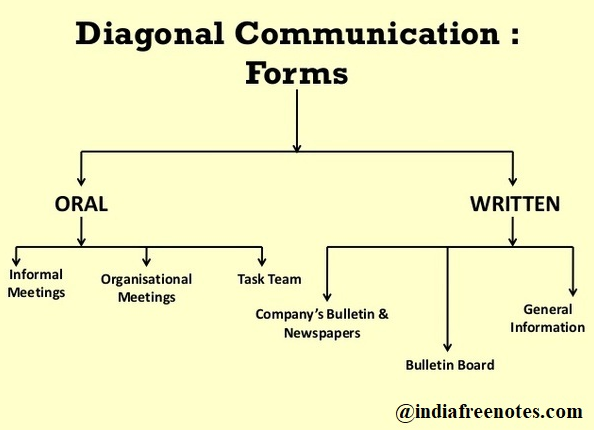Communication that takes place between a manager and employees of other workgroups is called diagonal communication. It generally does not appear on organizational chart. For instance to design a training module a training manager interacts with an Operations personnel to enquire about the way they perform their task.
The modern business environment requires organizations to develop effective communication processes to cope with increased employee involvement, flattened organizational structures, advances in communication technology and the move toward an economy based more on knowledge than traditional industrial and service skills. Barriers to communication such as language differences, information overload and strained relationships lead to mistakes, misunderstandings and interpersonal issues. Diagonal communication offers employees the opportunity to communicate effectively with the organizational hierarchy.

Importance of Diagonal Communication
(i) Necessity
Business organizations are highly complex, and so are the projects they undertake. Projects often require the cooperative efforts of more than one department, and of employees of varying levels within the involved departments. Furthermore, a project-group member may have a different status on the project than he has within the organization, so the hierarchy of the project group is less clear-cut than is the hierarchy of the organization. A diagonal communications route allows this functionally diverse group to share information directly, as required for the project’s execution, rather than according to a hierarchy that has little relevance to the project.
(ii) Efficiency
The standard method of communication between a subordinate in one department and a higher-up in another is for the subordinate to engage in upward communications with her supervisor, and for that supervisor to escalate the message until it reaches the level of its intended recipient. At that time, the message reaches the recipient via a horizontal engagement. It’s an inefficient process unnecessarily so, in many cases that risks miscommunication as the message passes from one individual to another. Diagonal communication routes eliminate this inefficiency.
(iii) Speed
The shortest distance between two points is a straight line. Diagonal communication routes are the straight lines that speed communications directly to their recipients, at the moment communication is necessary. Communications that zigzag along horizontal and vertical routes, on the other hand, are vulnerable to the schedules and whims of the individuals who pass them along.
(iv) Challenges
Ultimately, it’s up to management to determine when diagonal communications are appropriate. It’s important to trust diagonal communications to individuals who can be counted on to use them in a cooperative manner, for the benefit of the project, by maintaining the exchange on a formal-communications level.
